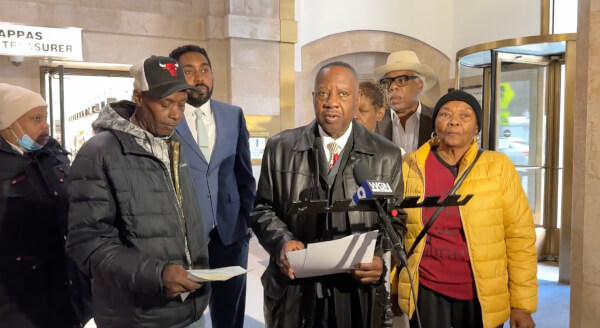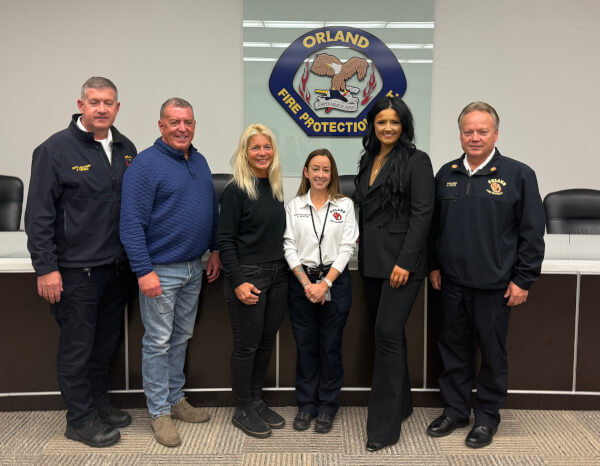SIU’s Touch of Nature removing invasive plants, restoring native flora and fauna
by Christi Mathis
The sweet-smelling flowers of bush honeysuckle and multiflora rose may look attractive in forests and yards, but in reality, they pose a serious danger to native flora and fauna. So Southern Illinois University Carbondale is taking action.
Along with autumn olive and a variety of other species, these plants were introduced into the United States landscape decades ago for various reasons, including wildlife food and cover, erosion control and ornamental purposes. Fast forward to today and those non-native invasive species (NNIS, as they’re commonly known), have spread like wildfire, taking over places like SIU’s beautiful Touch of Nature Outdoor Education Center as they crowd out native plant life and the critters it supports.
“But when we remove the invasive species, it allows the native plants and animals to function the way they were designed to in the natural environment,” said Charles Ruffner, forestry professor.
Led by Ruffner and Tom Brummer, assistant director of facilities and operations for TON, crews have spent 8 years treating 150 acres, largely in the main camp areas and along the roadways, out of the 3,300 acres in TON, which is about 8 miles south of Carbondale off Giant City Road.

“It’s just a start but a very visually effective one,” Brummer said.
Reclaiming the land
Eli Oberle, a senior forestry major from Cape Girardeau, Missouri, has been working hard for months to return the center’s forest to the state it once was before humans interfered.
“Since June, I have worked to improve several small timber stands,” Oberle said. “Specifically, I removed undesirable non-native species from the midstory and understory and treated various invasive species, mainly autumn olive. The work is important for two reasons. The land TON occupies was converted from agricultural use in relatively recent history. Many of these forest stands are still young. The groundwork we lay now will influence the health of the future forest. The other reason is the nature of the invasive species. They are not going anywhere. The focus has had to shift from eradication to management.”
Oberle has worked as an intern under Ruffner’s and Brummer’s supervision. He’s one of numerous SIU students and volunteers from the region and beyond who are contributing to the massive undertaking.
Why it matters
In many cases, the decline or even extinction in wildlife populations is the result of loss of food and/or habitat. Gray wolves, bison, cougars and American martens and other critters once made their home in the Midwest but no longer live here.
“Removing the autumn olive, honeysuckle and other NNIS allows the forest to return to a more natural state so the native creatures can survive. In this area, that means hickory and oak trees and other native plant life grow, providing acorns, hickory nuts and other food sources for the forest critters such as turkey, deer, rabbits, bobcats and other animals that are native to the region,” Ruffner said.
Ruffner and Brummer say Mother Nature has established delicate ecosystems that keep flora and fauna in balance if allowed to function as intended.
For instance, they noted, some 400-450 different species of animals and insects, from caterpillars to squirrels to bobcats rely on oak trees to survive. Oak trees go through a mast cycle every 5-10 years. That is, after several years of smaller acorn crops, which keep the populations of these animals in check, the oaks have a “mast year” with an abundance of acorns.
This ensures some acorns survive to grow into new trees, and the resulting boon in the animal populations that rely on the acorns improves the chances that some of the animals will survive the winter. But producing the large crop is hard work for an oak, and it temporarily stunts the tree’s growth and acorn production before the cycle begins all over again.
Extensive planning and work
Study, planning and restoration work at TON began in earnest about eight years ago as Ruffner’s team began preparing a land management plan for the property. Several undergraduate students completed an inventory of plant life at TON and used GIS mapping to plot everything. Graduate students studied past land management, looked at how it has changed through the years, and plotted where invasive species have taken over.
Along with Ruffner and Brummer, the team originally included Eric Holzmueller, professor of forestry; Megan Alkazoff, Western Ozarks fire and stewardship coordinator for the Nature Conservancy and double alumna of SIU; Ashley Bergman Hays, a teacher at Belleville West High School and double alumna of SIU; Leah Harper, a conservation easement forester at Washington State Department of Natural Resources and SIU master of forestry graduate; and Jeremy Schumacher, a herpetologist and forestry graduate who is a professional consulting forester with Ozark Koala Ecosystem Services. Since that time, numerous faculty, staff, undergraduate and graduate students and community members and organizations have gotten involved.
Bergman Hayes collected data, cited in her master’s thesis, that detailed the evolution of land use and forest conditions through changing land ownership and settlement patterns in the previous century at Touch of Nature. She examined the biodiversity, detailing that while originally the TON acreage featured native forest, prairie and wetlands, the majority of diverse flora was disturbed in the 1880s and 1890s. There are few trees remaining from the 1806-1860 era, likely indicative forest cutting by early settlers, and heavy cutting is believed to have resulted in the establishment of the existing oak-hickory trees dating to between 1880 and 1950. During that era, substantial sections were row cropped, turned into pasture for cattle breeds or planted as apple and peach orchards.
These were all virtually abandoned around the 1930s but ultimately purchased by SIU and protected since the 1960s. Somewhere along the way, at TON, as in many places across the country, state or federal agencies with the best intentions introduced bush honeysuckle, autumn olive and other non-native plants to create a protective bird and wildlife thicket/habitat, control erosion and accomplish other goals as well as for aesthetic reasons. At the time, officials didn’t realize the negative consequences, and the plants soon began overtaking everything around them.
Factors as diverse as animal grazing, abandonment, intrusion of invasive species, erosion and disturbances resulting from multiple strategic prescribed burns in the modern era and the derecho damage of 2008 have all had an impact on the land. Bergman Hays’ work provides insights about sound best practices for future management to help the park heal and ensure site productivity and usefulness, Brummer and Ruffner said.
Harper conducted research, also detailed in her master’s degree thesis, pertaining to the locations of the primary invasive species at TON and what can be done to control them. The survey revealed a strong presence of native and non-native invasive species and a minimal native white oak population. A variety of Harper’s recommendations, including forest mowing and providing herbicide treatments along rights-of-way, have been implemented.
Multi-pronged approach
Reclaiming the land as much as is feasible is a massive undertaking that requires considerable funding and intensive effort involving a diverse group of people and organizations.
The forest mowing project began with a “haircut” to eliminate some of the NNIS. The process included removing areas of NNIS by hand or mechanically using a mulcher. But professionals quickly discovered that this step wasn’t enough. Without chemical treatment, the plants resprout stronger than ever, with a thicker stem brace and denser branches.
“Even a tiny seed of an NNIS will take hold, root and regrow quickly, choking out the native plant life that has been reintroduced,” Ruffner said.
Thus, crews “judiciously” apply herbicides after cutting to totally eliminate the woody invasive species in spots. They equate it to the often-necessary act of giving radiation or chemotherapy to a patient with cancer to kill the unhealthy, cancerous cells in order to let the healthy cells thrive so the person can survive.
Efforts at this time to remove the NNIS are being focused on rights-of-way, Camp 1 and the access points for Camp 2. The camp is seeking additional grants to continue the work. Then teams will focus on the areas around the trails.
“We want people to see the forest through the trees,” Brummer said.
Oberle appreciates the hands-on lessons.
“The work is a perfect practical complement to the forestry courses at SIU,” Oberle said. “You can’t run a chainsaw in a lecture hall, no matter how much the professors would like to.”
Oberle plans to eventually return to Missouri and help manage timber on public and private lands.
“It’s a great training ground for a lot of our students,” Ruffner said. “TON has long been and continues to be a builder of careers. This takes multiple agencies and people as well as students to make it happen. It’s a cross-curriculum project for SIU and provides big lessons for the students. They learn the role of adaptive management and what’s involved in taking on a major project like this. They learn to ‘do no harm’ to the ecosystem and so much more.”
Three SIU groups are actively working on the project: TON, the forestry department and the Cooperative Wildlife Lab. Many other campus departments and programs have offered expertise including architecture, outdoor recreation, geography, plant biology and zoology, and numerous students, faculty, staff and volunteers have played vital roles in the work being done. SIU alumni Mike and Chris Long of Long Forestry Consulting have donated their time and a work crew. The camp works with certified arborist Roger Smith on hazardous tree removal.
In 2020, work really ramped up in the forest, with volunteer days and other special events. The SIU Forestry Club has donated its time many weekends, giving “countless volunteer hours,” Ruffner said.
“I always told them this could be their home away from home,” Brummer said.
“This place is special, and many of the students who were at SIU even back in the ’60s and ’70s remember this place. We’ve had marriages through our forestry program,” Ruffner said.
Working toward a different future
The land management plan comprises detailed maps, graphs, statistics and data for TON, broken down into park areas. The plan outlines what lies within the acreage, including 18.5 acres of water, the TON facilities as well as the SIU fisheries. There are also a few acres of grasslands, floodplain forest and sugar maple along with nearly 30 acres of oak savannah and more than 90 acres of loblolly pine.
The oldest trees SIU owns are in a remote, 80-acre section in the southern part of the park, Brummer said. There, in an area inaccessible to the public, is a state champion sugar maple. There are also endangered species of flora, including buffalo clover and fringed orchid at TON.
What’s the result of implementing the plan? A forest providing a more favorable environment to sustain and grow populations of bats, turkey, deer, small mammals and pollinators, Brummer said.
Brummer and Ruffner said they also hope to do a prairie restoration project at the camp, clearing some areas of NNIS and returning to a more natural prairie state. The large-scale project will require grant funding.
Forward-looking educational facility
In keeping with TON’s mission as an outdoor education center, crews have created educational demonstration plots in Camp I on Fern Ridge Road. Adjacent sections in the forest illustrate:
- Untreated land where NNIS have taken over the landscape.
- Land treated by mechanical or hand removal of invasive species.
- Acreage where invasive species have been removed followed by herbicide application.
- A section where the removal of NNIS has been completed and the native species are again reclaiming a stake on the land.
“This project creates learning opportunities at SIU’s outdoor learning center for graduate and undergraduate students as well as the public,” Brummer said.
TON has also begun having special educational events such as a late-summer “Landscaping With Native Plants Garden Tour” led by master Naturalist Lyle White to showcase the camp’s landscape and show people the importance and benefits of landscaping with native plants. Organizers say it’s vital for erosion control, reducing mowing, historical ethnobotany and preserving the region’s rare flora.
Project requires resources
Despite countless donations of time and labor, a project of this scope carries quite a price tag, Ruffner and Brummer noted. The land management plan and project are the result of two SIU Green Fund Grant Program awards to support the Forest History Lab, directed by Ruffner in collaboration with Holzmueller. A student Green Fee of about $10 per semester, was adopted in 2009 as the result of a student-led initiative, has provided more than $50,000 in grants that have funded work by graduate students to inventory the forest, create GIS maps reflecting the inventory, a project by Illinois botanizer Chris Benda to complete a plant survey and other facets of the project.
Grants, donations and other funding for the ongoing work have come from a variety of other sources as well, including:
- The Illinois Forestry Development Council (the largest funder).
- Illinois Forestry Association.
- SIU forestry program.
- TON.
- Smith Tree Farm.
- Egyptian Electric Cooperative.
- Fabick Rentals.
- Linda Brandon.
- AmeriCorps National Civilian Community Corp.
Egyptian Electric Coop has also provided herbicide resistant pollinator seed and assistance with training and testing.
Brummer said TON welcomes additional groups as well as volunteers and financial gifts to help continue their efforts. For more information about the camp or getting involved in the effort to restore native species, visit the website, call 618-453-1121 or email [email protected].
(This article was submitted for publication by SIU)

- Orland Park Statement on Settlement of William Sanchez vs. Village of Orland Park, et al., Lawsuit - December 5, 2025
- Cook County Treasurer Maria Pappas column explores options to help pay property taxes by Dec. 15 - December 5, 2025
- WalletHub releases Credit Card Debt study, shows $16 billion increase - December 5, 2025
























